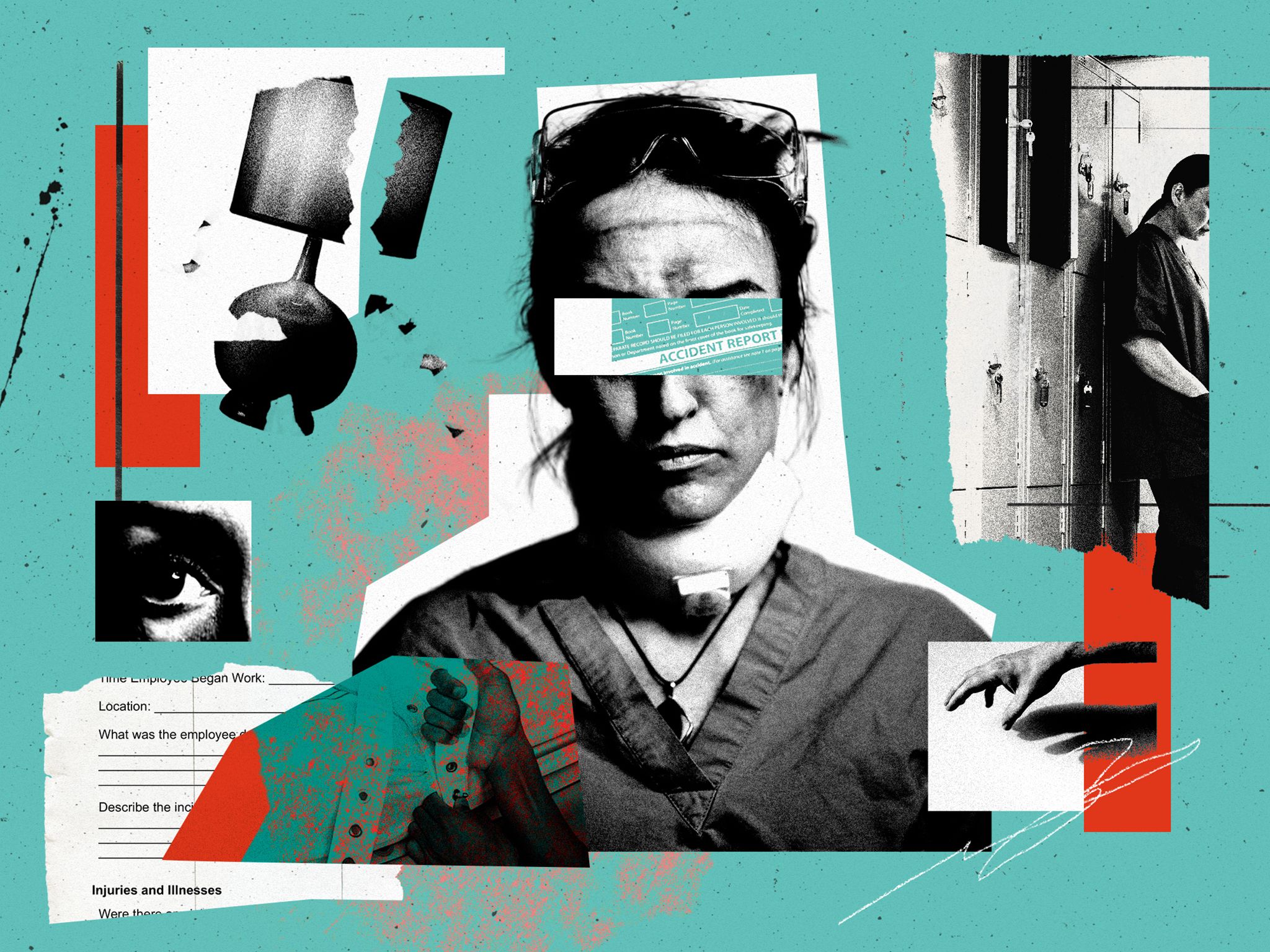Nurses Are Breaking Point: What They’re Not Telling You Could Change Healthcare Forever
Two weeks into her emergency department orientation at a Seattle hospital, 21-year-old nurse Kelsey found herself in a nightmare no one should face on day one—threatened, attacked, and barely escaping harm. Can you imagine starting a new job and immediately wondering if you’ll make it out alive? It sounds unbelievable, but this is the harsh reality for nurses across America. Behind the hospital walls, where care should be the priority, violence toward nurses has become frighteningly routine—so common that it’s even making its way into prime-time drama. But if you think it’s just dramatized TV chaos, think again. Assaults, threats, and trauma are stalking our healthcare heroes daily, yet the systems meant to protect them are failing, underfunded, or downright absent. How did we get here—and more importantly, can we fix this before the crisis cripples an already stretched healthcare system? This isn’t just a story about one nurse or hospital; it’s about a systemic problem tearing at the very fabric of patient care and the people sworn to provide it. Ready to dive into the unfiltered truth about violence against nurses and what it means for all of us? LEARN MORE
Two weeks into her emergency department orientation at a Seattle hospital, Kelsey, a 21-year-old nurse, was already starting to worry she might not leave work alive that day. Her patient, bound in six-point restraints, hurled threats at Kelsey, telling her that she was going to come to her house and skin her with a razor blade.
Trying to compartmentalize her fear, Kelsey followed orders to sedate the patient. As she approached her with the syringe, the patient, who had managed to free herself from the restraints, grabbed Kelsey’s arm and attempted to turn the syringe to inject Kelsey instead. Security was able to wrestle the syringe from the patient, but that didn’t prevent more attacks for the remainder of Kelsey’s shift—she recalls dodging punches from the patient before another nurse called a “code gray,” a signal used in hospitals to indicate a security concern, like a combative patient.
“I just remember walking out of that room, and my preceptor [a supervising nurse] was like, ‘Yep, welcome to nursing,’ ” Kelsey says.
In the aftermath, Kelsey spent months trying to parse her feelings about the incident. Who was to blame? Her coworkers discouraged her from filing an incident report. Many of them had already experienced countless violent situations in their hospital, and management rarely acted on their concerns or increased staff safety measures. It would have been easy for Kelsey to villainize the patient, but she knew the individual was sick. Still, both of them had been put at risk that day, and Kelsey had been left without adequate training or resources to handle the violence.
In hospitals across the country, nurses are being threatened, punched, kicked, and even killed. It’s a crisis hiding in plain sight—and on our television screens. This violence has become such a normalized part of a nurse’s job that it’s now highlighted on Max’s new hit hospital drama, The Pitt. Viewers watch as charge nurse Dana Evans gets brutally punched in the face by an angry patient during a particularly chaotic shift.
True to the pop culture depiction, assaults by patients and family members alike have become terrifyingly common in the nursing world. These incidents, which were already on the rise pre-2020, accelerated during the pandemic, and many hospitals still lack effective reporting systems or adequate responses from management. Nearly half of respondents in a recent National Nurses United (NNU) survey reported a rise in violence from the previous year, with 26.3 percent saying violence “increased a lot,” yet union occupational health professionals estimate that up to 90 percent of these incidents go unreported, according to Jane Thomason, lead industrial hygienist at NNU.
Maureen, a registered nurse of nearly four decades, was beginning her shift in a Philadelphia-area neonatal ICU when a fellow nurse ran to her, shaking. A patient’s father had become aggressive and threatened to kill her. When Maureen urged her to file an incident report, the nurse looked confused. Reporting an incident takes time, and nurses juggling heavy patient loads at understaffed hospitals often just push forward. And without effective protocols, hospital-specific or federal, some nurses aren’t even aware that they can report these events when they happen. So they shrug them off. “We’re so used to taking the heat,” Maureen says. The death threat, though reported, was not acknowledged by the hospital until Maureen sent out a company-wide email about it.
Between 2021 and 2022, health care professionals experienced more incidents of workplace violence than employees in any other sector of private industry, according to the U.S. Bureau of Labor Statistics. Over a three-month period in 2022, roughly 57 assaults on nurses occurred each day across the country, meaning that more than two nurses were assaulted every hour, found a study from Press Ganey. And 8 in 10 nurses experienced some degree of workplace violence in 2022, revealed the NNU survey.
Despite all this, there are no strict federal guidelines for health care employers regarding the reporting of workplace violence, which results in an epidemic of issues occurring on the regular—especially in emergency rooms. Is it any wonder that we’re dealing with a nurse shortage in the U.S.?
An Empty Bench—and a Looming Chasm
Yes, nurses are leaving the field at an alarming rate, exacerbating the staffing shortages and putting an already struggling health care system in even more dire straits. Federal authorities warn that the nation will need more than 63,000 additional nurses by 2030—a shortfall that’s driven by deteriorating working conditions, including workplace violence. Of course, there are countless ripple effects too. Fewer staff means longer hospital stays, higher patient mortality rates, and more preventable medical errors. And if there aren’t enough nurses to meet demand, a health care system collapse isn’t farfetched.
Several nurses interviewed for this article say that nurses entering the field are ill-equipped to deal with the job’s brutal realities. There’s also a lack of mentorship from more experienced peers, partly due to working conditions that don’t allow the necessary time for this. Nurses still in orientation have to care for patients they aren’t yet prepared to handle. It’s not exactly a selling point for the profession. Retaining new nurses has become especially challenging, says Kerrie, a Boston emergency room nurse. “Everyone’s job is difficult enough,” she says. “Then you throw on this aspect of the abuse—nobody wants to go to work every day and deal with that.”
“Everyone’s job is difficult. Then you throw on this aspect of abuse—nobody wants to go to work every day and deal with that.”
Kerrie, a nurse in Boston
Even when a nurse does everything right during and after an incident—de-escalates the situation, cares for the patient, and files a report—management usually asks them what they could have done differently instead of “what the system” could have done differently, says Anne Piazza, executive director of the Oregon Nurses Association. “That’s a huge deterrent for nurses even reporting [incidents],” she adds.
This lack of confidence in hospital leadership to address workplace violence is also driving many nurses away from the bedside each year. In fact, more than 138,000 nurses left the industry after COVID-19, and in a recent survey of 800,000 nurses by the National Council of State Boards of Nursing, 40 percent said they plan to leave by 2029, largely due to burnout and emotional fatigue worsened by staffing issues and hospital conditions, including violent incidents on the job.
“I just talked to a nurse the other day who’s been in the [emergency department] for more than 10 years and who just went through another traumatic workplace violent incident, and she said, ‘I’m done,’ ” Piazza says. “She looked me in the eye and said, ‘You need to understand, I am not safe. I am never safe, period.’ ”
Risking Body, Mind, and Soul
Indeed, it’s not only nurses’ physical health that is at risk from one of these traumatic events.
More than 65 percent of nurses in the NNU survey reported fear and anxiety on the job based on their experiences with violence in 2022. Another study estimated that 28.4 percent could meet the criteria for post-traumatic stress disorder, with 15.4 percent experiencing severe symptoms. Repeated exposure to verbal abuse, profanity, and emotional mistreatment from patients—something Farinaz Havaei, PhD, an associate professor at the University of British Columbia School of Nursing, calls “chronic microaggressions”—significantly increases mental health issues among nurses.
When it comes to the type of intense attacks that Kelsey, the Seattle nurse, endured, “the primary consequence is going to be PTSD,” Havaei says.
The psychological impact can be so severe that nurses actually have a term to describe the distress: moral injury.
For her part, Kelsey started going to therapy and taking antidepressants. Still, she has nightmares almost every night. One time, she and 30 other nurses joked about their therapy sessions. “I was like, ‘Hey, raise your hand if there are things that you don’t tell your therapist because you’re afraid of traumatizing your therapist,’ ” Kelsey recalls. Every single person raised their hand.
Even if their workplaces happen to offer mental health resources, many nurses say those measures feel limited or out of touch, like having pizza parties or providing self-care tips instead of addressing the deeper, systemic issues. (You can see why a free slice of pepperoni pizza in the break room wouldn’t quite do it for nurses who may fear for their lives.)
New organizations, like the Emotional PPE Project (EPPE), have emerged to connect health care workers with free, licensed mental health providers. Kimberly Johnson, PhD, LMHC, an EPPE board member, has seen firsthand what’s happening, including the surge in nurses struggling with PTSD, anxiety, sleep disturbances, and burnout. Johnson worries about the long-term implications for nurses if there isn’t major, system-wide change. “Not only will nurses begin to deteriorate, but the quality of the services provided in health care settings will also worsen,” she says. “We’re going to see more people calling out sick, leaving the field, or working even while struggling and unwell…. We’re going to continue to see a rise in substance use and more cases of untreated mental health issues. The truth is that all of it is preventable.”
Some mornings before her shift, Ana, a pseudonym for an ICU nurse in Tacoma, Washington, who asked for anonymity, sits anxiously in her car, talking herself into entering the hospital. She recalls sitting down on her couch at home with no phone or TV and completely zoning out—for hours. “It’s not like the true definition of dissociating, but it’s pretty dang close—where you just don’t exist for a time,” Ana says.
Lexi, a Seattle-based pediatric RN, echoes that sentiment. She was recently diagnosed with PTSD after experiencing vivid nightmares, intense mood changes, and general anxiety, which, she says, many of her coworkers also deal with.
“I will come home and can’t tolerate being touched, just because I am so overworked, or overwhelmed from work, or because it was so traumatic. I really just need physical body autonomy for a while,” Lexi says. “But I am really lucky because I think the people that I work with are wonderful and resilient, and honestly, probably more resilient than they should ever need to be.”
Maureen’s nurses “look like they’re on a battlefield,” she says. Their faces seem to say, “ ‘I cannot do another day like I just did.’ It looks like ‘I don’t even know if I want to be a nurse again.’ ”
Yet the nurses show up day after day to care for their patients, even though it often feels as if no one is taking care of them.
A Lack of Legislation
While the Occupational Safety and Health Act, signed into law in 1970, requires under its General Duty Clause that employers provide a workplace “free from recognized hazards that are causing or are likely to cause death or serious physical harm,” there are no specific standards or guidelines when it comes to incidents of workplace violence. So, the responsibility for preventing them falls on the employer. Enforceable standards from the Occupational Safety and Health Administration (OSHA) would require employers to have a plan to prevent workplace violence, something union reps say employers are not doing on their own.
Currently, hospitals have to report only fatalities and severe injuries (those requiring treatment beyond first aid) to OSHA. Proposed federal funding cuts by the House of Representatives include a 12 percent decrease in OSHA’s budget, which would further impact its ability to enforce safety standards and prevent workplace injuries.
At a Kansas hospital, a veteran nurse named Shelly says that until last year there was no system for reporting violent incidents to management, and she wonders how the problem can be addressed without a way to track it. “It’s the hospital’s responsibility to have a safe place for nurses to work,” Shelly says. Employees at the hospital have since unionized to fight for a safer environment.
Since 2024, their contracts have included provisions for better protecting nurses from violence and for reporting incidents, but the union is fighting for a more comprehensive reporting system.
“What we need is an enforceable mandate [from the government] to clarify for employers what they need to be doing,” says Thomason. “Because right now, they’re not doing what they need to do voluntarily.”
So far, only eight states require that health care employers have violence protection guidelines, which mandate the reporting of violent incidents.
“We need an enforceable mandate to clarify for employers what they need to be doing. Because right now, they’re not doing it voluntarily.”
Jane Thomason, NNU
In 2014, California passed a law increasing workplace safety regulations after a nurse named Cynthia Palomata was murdered by an inmate at the Contra Costa County Jail, where she worked. The inmate had faked a seizure and then fatally struck Palomata on the head with a table lamp. The state, which NNU considers to be the gold standard when it comes to workplace violence prevention laws, now demands that employers take comprehensive violence prevention measures, including maintaining sufficient staff, identifying environmental risks, mandating de-escalation training, and requiring the reporting of every violent incident to California’s OSHA division through a public reporting process.
Legislators in other states, like Oregon, are pushing for laws requiring workplace violence prevention plans and funding for metal detectors in hospitals. In February, Washington passed a bill requiring health care facilities to develop and implement workplace violence prevention plans, including security, staffing, training, and incident reporting provisions.
In New York, violence-related coverage is limited to workers in publicly funded health care facilities, so those working in private hospitals have a more challenging time pursuing legal recourse. And since hospitals rarely report low-level violent incidents, like verbal assaults or minor physical altercations, to OSHA, the agency rarely gets involved, according to a representative from the New York Committee for Occupational Safety and Health (NYCOSH), a nonprofit founded to improve workplace safety conditions.
New York’s Department of Labor does have a bureau that can enforce OSHA safety standards, called Public Employee Safety & Health (PESH), but it’s available only to public sector workers. Independent agencies like the not-for-profit Joint Commission also conduct hospital inspections to evaluate patient and staff safety. But a NYCOSH representative says its assessments generally don’t yield much change, partly because many employers know when the visits will occur and plan accordingly: Patients crowding the hallways of the emergency department evaporate, and non-nurse staff are brought in to monitor aggressive patients. “Everything’s hunky-dory when the Joint Commission shows up,” the representative says.
With no recourse, nurses have little choice but to shift matters into their own hands.
Taking Charge
In October 2018, after 34 years of working in the mental health department at a state hospital in Massachusetts, a nurse named Karen had finally had enough. Throughout her career, she’d noticed that the violent incidents typical of psychiatric units or emergency departments were infiltrating all areas of health care.
Karen says she’s been punched, spat on, kicked, and had weapons pulled on her. She’s even seen colleagues suffer career-ending traumatic brain injuries and one lose peripheral vision after being assaulted while treating patients. For years, Karen’s husband and son grew increasingly concerned for her safety, to the point where her son once asked if anyone had tried to kill her that day.
At Karen’s workplace, she says, incidents reported to management almost never receive a follow-up. If a nurse wants to call the police or file charges as a last resort for getting help, Karen says, doing so is the nurse’s burden, so her colleagues rarely take that step.
Lexi, the pediatric nurse in Seattle, was forced to call the police when a young patient began aggressively wielding a scale and had to be barricaded in his room. She issued a “code silver”—used for patients with weapons—but says hospital leadership pushed back, claiming it applied only to guns. Lexi knew that wasn’t true, insisting the code was for all weapons, and management eventually acquiesced.
When a police officer arrived, he was perplexed to find the nurses wearing hockey helmets. “The officer was like, ‘Oh my gosh, so exciting that you could play hockey on the unit.’ And we were like, ‘This is [to prevent] concussions,’ ” Lexi says, adding that the volume of incidents each day makes it hard to remember them all.
“I’ve seen friends of mine dragged by their hair through the unit at least, like, three or four feet by a patient until someone was able to get the patient off of them,” she says. “I’ve had probably over 20 of my friends concussed. I’ve had two friends drop out of school because their cognitive function changed after an assault.”
Kerrie, the emergency room nurse in Boston, says she pressed charges against a patient who verbally assaulted her and threatened to kill her. She says her ER’s conditions are “deplorable” and security is inadequate. “I’ve just reached a point, like, when it’s every single day, every single shift that somebody in that department is getting abused,” Kerrie says. She recalls a security guard once commenting that dealing with the chaos of a violent patient is what nurses signed up for. “We signed up to take care of patients,” she told him. “We didn’t sign up to come into work to be threatened and assaulted.”
Hospital management seems to have “forgotten that the true mission is to take care of patients,” says Kerrie.
What It’ll Take to Change an Industry
Without adequate reporting systems, change—including new legislation—that could better protect hospital staff is an uphill battle.
Thankfully, a new generation of nurses is starting to speak up, and those in power have begun paying closer attention. “They’re demanding safety, and they’re demanding more resources, and they’re demanding better staffing, and if they don’t get it, they leave,” says Kerrie.
Legislators are aware of these long-standing issues, but major shifts take time. “For years, employers have refused to work with us to implement workplace violence prevention plans and to address the staffing crisis that creates the conditions for workplace violence,” said Nancy Hagans, the president of NNU, in an April press release. “Congress can support frontline health care workers by requiring employers to invest in proven measures to prevent violence in our workplaces.”
Congressman Joe Courtney, a Democrat from Connecticut, introduced the Workplace Violence Prevention for Health Care and Social Service Workers Act, which passed in the House of Representatives with bipartisan support in 2019 and 2021 but is still awaiting action in the Senate. It would require the Department of Labor to mandate that health care employers document and investigate violent incidents, provide prevention training, and implement safety measures. “I have been married to a nurse practitioner for 35 years and heard from my wife about the abuse and risk of harm that has become commonplace in health care,” Courtney said in a statement to Women’s Health. “Workplace violence is not a ‘fact of life’—we can significantly reduce it with smart, enforceable protections.”
As new systems and procedures are developed at the federal and employer level, nurses say it is essential that they be involved. “They are the ones with firsthand experience,” says Havaei, of the UBC School of Nursing. “Unless nurses are able to actually speak to their experiences and give recommendations in terms of what they think is going to make a difference, we’re not going to be able to tackle this issue.”
In a recent survey of 800,000 nurses, 40 percent said they plan to leave the industry by 2029.
Source: National Council of State Boards of Nursing
While there’s no silver bullet to eliminate workplace violence, unions and organizations like the American Nurses Association and the National Council of State Boards of Nursing are pushing for stronger safety protocols during contract negotiations—including clearer language around training, increased security (such as metal detectors), safe staffing ratios, and the use of trained “behavioral health aides” who can monitor and help de-escalate situations involving agitated patients. They unanimously stress the importance of incident reporting—and reinforce that data can help fuel advocacy efforts.
Other proposed measures include general de-escalation training and clear instructions on reporting incidents (and what happens afterward). They also want nurses to be directly involved in the creation of these new protocols. “We’re constantly trying to provide nurses with the information they need about what their legal rights are, in terms of reporting and how important it is to hold their employers accountable for putting in place prevention measures,” says Thomason.
Security varies widely across hospitals, and several nurses interviewed for this article recalled weapons such as guns and knives entering their workplaces. After two bullets struck the windows of her hospital’s ER, Maureen renewed her push for metal detectors at all emergency entrances. The request was finally prioritized after the incident, but Maureen says security remains inadequate.
Kerrie remains hopeful, pointing to ongoing nurses’ strikes nationwide and the increased public awareness of the industry’s struggles, thanks to shows like The Pitt.
“I think changes will come,” she says. “You’re seeing so many more nurses who are turning to unions to say, ‘I recognize it now. I want to have a voice at the table because I know if I’m not at that table, I’m on the menu, and we’re not going to stand for that.’ ”
But for Kelsey, the struggle to keep patients and staff safe feels unrelenting. “What really takes a toll is all of this together,” she says. “One of my favorite managers recently quit, and she worded it best. She said it’s like hitting your head against a wall to move the brick wall, and you might make a little progress, but at what cost?”























Post Comment